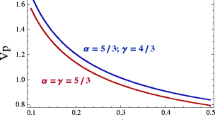Abstract
This paper calculates the two-dimensional flow of a two-component cold nondissipative plasma. The condition is found for which a nondissipative plasma can escape from a magnetic field.
A distinction must be made between those plasma accelerators which operate at high densities n≳1016cm−3 and those which operate at low densities (n≲1014 cm−3).
In the first case the acceleration of ions may occur not only as a result of internal electric fields, but also as a result of the collision of ions with each other (ordinary thermal acceleration) or the collision of ions with elections moving as a result of the Hall* effect along the accelerator channel.
In the second case the only mechanism capable of accelerating the ions is the internal longitudinal electric field [1, 2]. This treatment excludes those systems [3], in which the ions are accelerated as a result of kinetic instabilities.
The present paper treats the acceleration of a low-density plasma. A box-type accelerator has been chosen by way of example, since in this case the peculiarities of low-density accelerating systems are particularly marked.
Three conditions must be fulfilled in order to create a box-type accelerator operating at low densities.
Firstly, we must make use of segmented electrodes, since otherwise it is impossible to create in the space inside the accelerator electric fields of the type (2.11) necessary for accelerating the plasma. For continuous electrodes the structure of the electric field in the space inside the accelerator results from the superposition and interaction of exceedingly complex processes at the boundaries and in the vicinity of the electrodes.
Secondly, if the system under consideration is intended to produce high velocities, then it is necessary to create conditions under which there is no interaction of the fast particle flux with the walls. In other words, the current in the system must be controlled electromagnetically and not by means of the walls, which is the case in ordinary gasdynamic nozzles.
It should be noted that in high-velocity plasma accelerators which produce ions with energies ≳100, it is essential to eliminate the interaction of the current with the walls at higher densities also. Thirdly and lastly, conditions must be created which ensure the escape of the plasma from the magnetic field.
It was shown in [4] that the magnetic field is in fact“frozen” into the electronic component of the plasma, and so a necessary condition for a compensating current to escape from the magnetic field is that the exchange parameter §≫1 should be large.
The present paper develops the theory of the supersonic part of a box-type accelerator. It should be noted that many papers [5–8] have been devoted to the theory of the box-type accelerator. These, however, were written on the assumption either that the medium is incompressible or for the quasi-one-dimensional approximation in which the flow is of necessity given a particular geometry. These assumptions are, of course, very far removed from reality, at least as far as the production of high-velocity flows is concerned.
Similar content being viewed by others
References
A. I. Morozov, “The acceleration of a plasma by a magnetic field,” ZhETF, vol. 32, p. 305, 1957.
A. I. Morozov and L. S. Solov'ev, “Plane flow of an ideally conducting compressible fluid taking the Hall effect into account,” ZhETF, vol. 34, p. 1141, 1964.
M. V. Nezlin and A. M. Solntsev, “The acceleration of ions in plasma beams,” ZhETF, vol. 45, p. 840, 1963.
A. I. Morozov and L. S. Solov'ev,“A certain similarity parameter in the theory of plasma flow,” DANSSSR, vol. 150, p. 725, 1965.
G. Wood and A. Carter, Considerations of NASA relating to the construction of a continuous plasma accelerator,” collection: Ion, Plasma, and Arc Rocket Motors [Russian translation], Gosatomizdat, 1961.
A. B. Vatazhin, “Some two-dimensional problems of current distribution in an electrically conducting medium moving along a channel in a magnetic field,” PMTF, no. 2, p. 39, 1963.
G. Sutton and A. Carlson, “End effects in inviscid flow in a magnetohydrodynamic channel,” collection: The Magnetohydrodynamic Method of Energy Conversion [Russian translation], Fizmatgiz, 1963.
L. E. Kalikhman, The Elements of Magnetogasdynamics [in Russian], Atomizdat, 1964.
A. I. Morozov and L. S. Solov'ev, “Geometry of the magnetic field,” collection: Problems of Plasma Theory [in Russian], Gosatomizdat, no. 2, 1963.
A. I. Morozov, “The focusing of cold quasineutral beams in electromagnetic fields,” DAN SSSR, vol. 163, p. 1363, 1965.
Author information
Authors and Affiliations
Additional information
In conclusion the author is grateful to A. I. Bugrov, L. E. Kalikhman, and L. S. Solov'ev for discussing the questions raised.
Rights and permissions
About this article
Cite this article
Morozov, A.I. Theory of the supersonic part of a nondissipative box-type accelerator. J Appl Mech Tech Phys 7, 20–23 (1966). https://doi.org/10.1007/BF00916967
Issue Date:
DOI: https://doi.org/10.1007/BF00916967




